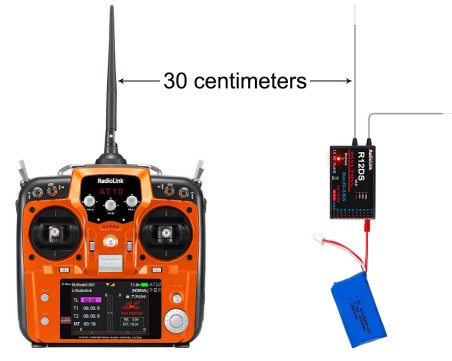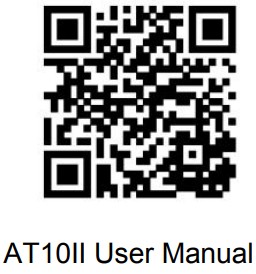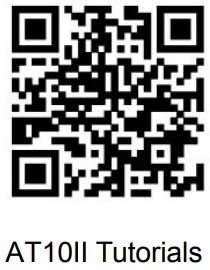 AT10II
AT10II
QuickStartGuide
(Helicopter/Fixed-wing/Glider
Multirotor/Car/Boat/Robot)
12 channels transmitter CE FCC RoHS
CE FCC RoHS
Safety Precautions
![]() Never operate your model during adverse weather conditions. Poor visibility can cause disorientation and loss of control of your model.
Never operate your model during adverse weather conditions. Poor visibility can cause disorientation and loss of control of your model.![]() Never use this product in a crowded and illegal area and strictly comply with the local regulations.
Never use this product in a crowded and illegal area and strictly comply with the local regulations.![]() Aways ensure the trim levers at 0 and battery properly charged before connecting the receiver.
Aways ensure the trim levers at 0 and battery properly charged before connecting the receiver.![]() Always check all servos and their connections prior to each run
Always check all servos and their connections prior to each run![]() Mutti-rotor must check whether the motor rotation direction is nomal
Mutti-rotor must check whether the motor rotation direction is nomal![]() Atways be sure about turning off the receiver before the transmitter.
Atways be sure about turning off the receiver before the transmitter.![]() The AT10Il transmitter cannot be restored to factory settings, but the currently used model can be reset in “BASIC MENU”-“MODEL TYPE”
The AT10Il transmitter cannot be restored to factory settings, but the currently used model can be reset in “BASIC MENU”-“MODEL TYPE”![]() Please strictly abide by local laws and regulations and use it safely!
Please strictly abide by local laws and regulations and use it safely!
This product is not a toy and is NOT sitable for children under the age of 14. Adults should keep the product out of the reach of children and exercise caution when operating this product in the presence of children.
Packing List

Specifications
| AT1011 Transmitter | |
| Size | 180*95*220mm (7.1″*3.7″*8.7″ ) |
| Weight | 0.95kg(2.1 lb) |
| Channel Quantity | 12 (all twelve channels can be customized) |
| Control Range | More than 4000 meters in the air, and 2000 meters on the ground. The actual control distance depends on the environment. |
| Operating Current | <105mA |
| Operating Voltage | 7.4 ∼ 15.0V (8pcs AA battery, a 2S-4S LiPo or 18650 Lithium battery, Li-ion, NiMH or NiCad battery) |
| ACPR | >38dbm |
| Transmitter Power | <100mW (20dbm) |
| Frequencies Band | 2.4GHz ISM band (2400MHz-2483.5MHz) |
| Modulation Mode | QPSK |
| Bandwidth | 5.0MHz |
| Spread Spectrum Mode | DSSS&FHSS |
| Storage Model Quantity | 15 |
| Battery Box Size | 115*32*30.5mm(L*W*H=4.53″*1.26″*1.2″) |
| Low Voltage Alarm | Support. Voltage alarm can be customized |
| Signal Output | PWM/SBUS/PPM |
| Simulator Mode | Yes, with the radio frequency off to save battery power |
| Screen | 3.5 inches 16 colorful screens, 320*480 pixels |
| Operating Temperature | -20° to 85° C (-4° to 185° F) |
| Adaptable Models | include all 120-degree and 90-degree swash-plate helicopters, all fixed wings, gliders, multirotor, RC cars, RC boats, and Robot |
| Compatible Receivers | R12DS(Standard), R12DSM, R9DS, R6DS, R6DSM |
| R12DS Receiver | |
| Size | 50*32*14.5mm (1.97″1.24″0.57″) |
| Weight | 14g (0.49oz) |
| Antenna Length | 215mm (8.46″) |
| Channel Quantity | 11 channels for PWM signal output; 12 channels for SBUS&PWM signal output |
| Control Range | More than 4000 meters in the air, and 2000 meters on the ground. The maximum range tested in unobstructed areas free of interference and depends on the environment. |
| Operating Current | 38∼45mA@5V |
| Operating Voltage | 3.6-12V |
| Signal Output | PWM(red LED) and PWM&SBUS(blue/purple LED) |
| Section Precision | 4096, 0.25us per section |
| Compatible extended telemetry module | Connect PRM-01 for model voltage telemetry. Connect PRM-03 and flight controller crossflight, PIXHAWK, Mini Pix, and TURBO PiX, APM for OSD information telemetry |
| Compatible Transmitters | AT1011/AT10/AT9S Pro/AT9S/AT9 |
Transmitter AT10II

Basic Operations

Note : For normal functions, short press the PUSH button to confirm, but when modifying the “MODEL SEL” and “MODE TYPE”, long press the PUSH button for 1 second to confirm.
- Aileron/Elevator/Throttie/Rudder Stick controls 1 to 4 channels by default. Set STK-MODE in PARAMETER menu. If you set the STK-MODE to “” and then the AUX-CH in BASIC MENU, you can assign other switches to control channel 1 to channel 4.
- Three VR knob switches on the front and two VR slider switches on the side meet the needs of panttilt control, and the functions of these switches can be customized
- AT10Il has 4 two-way switches, 3 three-way switches and a reset switch. Function of all switches can be customized. For details, please refer to the detailed manual of AT101I www.radiolink.com/at10ii_manuals.
Basic Settings
- Language Settings: Long press the MODE button to enter the menu, if the language is displayed as Chinese, please rotate the PUSH button to move the cursor to PARAMETER, short press the PUSH button to enter the setting interface, and change the language from Chinese to English.
- Alarm Settings: The low voltage alarm of the fransmitter, receiver, model battery and RSSI(Received Signal Strength Indicator) alarm can be customized on AT10I1. The factory low voltage alarm is 8.6V for transmitter; 4.0V for receiver; 11.1V for model battery. When the voltage is lower than the set alarm value, the transmitter will send out an alamm (See pictures below), and the low battery alarm can be set according to the actual voltage of the battery to avoid battery
over-discharge. Setting steps: BASIC menu – PARAMETER – TX-ALARM/RX-ALARM/EXT-ALARM. (Voltage alarm reference: 25 lithium battery -7.4V; 3S lithium battery -11.1V; 4S lithium battery -14.8V.) The RSS! alam is turned off by default. The alarm value can be customized. When the signal strength is lower than the set alamm value, the transmitter will send out an alarm (See picture below). Setting steps: BASIC menu – SYSTEM – RSSI ALM.
Setting steps: BASIC menu – PARAMETER – TX-ALARM/RX-ALARM/EXT-ALARM. (Voltage alarm reference: 25 lithium battery -7.4V; 3S lithium battery -11.1V; 4S lithium battery -14.8V.) The RSS! alam is turned off by default. The alarm value can be customized. When the signal strength is lower than the set alamm value, the transmitter will send out an alarm (See picture below). Setting steps: BASIC menu – SYSTEM – RSSI ALM. 
R12DS Receiver
Working Modes
R12DS, with 24G DSSS&FHSS spread spectrum technology, is a 11-channel receiver when working with PWM signal output (red LED) or a 12-channel receiver when with SBUS&PWM signal output (purple/blue LED)
- PWM Signal Mode : Red LED indicates PWM signal output, 11 channels totally.


- SBUS&PWM Signal Mode: Blue/purple LED indicates SBUS&PWM signal output at the same time with 12 channels totally. The eleventh channel outputs SBUS signal while the original CH1 outputs CH3 PWM signal and original CH2 to CH10 output CH4 to CH12 PWM signal at the same time.

Note: Fixed wing equipped with flight controller is taken as an example.
Switch Signal Mode : Short press binding button (ID SET) twice within 1 second, the working mode will be switched.
Channel Settings
AT10Il is a 12-channel transmitter. The channel is selected as 12 channels by default (See the right picture). When using the standard packed R12DS receiver, there is no need to modify the settings; but when using RODS, REDS or REDSM receiver, channel of AT10ll should be selected as 10 channels, 10CH. For the channel selection of AT10Il when using different receivers, please refer to the figure below: 
| ReceiverModel | AT10II CH-SELECT |
| R9DS | 10CH |
| R6DS | 10CH |
| R6DSM | 10CH |
| Receiver Model | AT10ll CH-SELECT |
| R12DS | 12CH |
| R12DSM | 12CH |
Setting steps: BASIC menu – SYSTEM – CH-SELECT.
Note If the channel of AT10Il is selected incorrectly, the servo may vibrate all the time.
Binding
AT 101l and R12DS have already finished binding by default. Tum on AT10ll and R12DS, the signal tower will be displayed on the top of the screen (See the right picture), which means the transmitter and receiver have finished binding .
If you purchase a new R12DS receiver separately, you need to bind the receiver to the transmitter. Each receiver has an individual ID code. When the binding is done, the ID code will be stored in the transmitter and there’s no need to rebind. Binding Steps:
Binding Steps:
- Put the transmitter and the receiver close to each other (about 30 centimeters).
- Power on AT10ll and R12DS, the LED of R12DS will be on
- There is a black binding button (ID SET) on the side of receiver. Press the button for more than one second and release, the LED of the receiver will flash, meaning binding process is ongoing
- When the LED stops flashing and is always on, binding is complete. There will be a signal tower shown on top of the LCD screen of the transmitter. If not succeed, the LED will keep flashing slowly to notify, repeat the above steps.
Note : Since RadioLink radio control systems are not open sourced, RadioLink transmitters are ONLY compatible with RadioLink receivers.
Installment of Antenna
- Receiver Antenna Installment
1. Please test RSSI (Received Signal Strength Indicator) before operating models. For methods on how to test it, please refer to https://www.radiolink.com/newsinfo/477894.html
2. If the antenna of the receiver is damaged, replace it with a new antenna or receiver in time.
3. Keep antennas as straight as possible and 90° as shown on the right, or the effective control range will reduce. 4. Big models may contain metal parts that influence signal emission. In this case, antenna should be positioned at one side of the model to ensure the best signal status in all circumstances.
4. Big models may contain metal parts that influence signal emission. In this case, antenna should be positioned at one side of the model to ensure the best signal status in all circumstances.
5. Antennas should be kept away from metal conductor and carbon fiber at least half inch away and no over bending
6. Keep antennas away from motor, ESC, or other possible interference sources.
7. Receiver contains some electronic components of high-precision. Be careful to avoid strong vibration and high temperature. - Transmitter Antenna Orientation
1. The transmitter antenna orientation is adjustable. Please make sure that the antenna never points directly at the model when flying as this may possibly decrease the receiver signal (See Picture 1 below)
2. If the antenna is upright, the antenna signal mainly diverges in the horizontal direction, which is beneficial to flying farther (See Picture 2 below); if the antenna is horizontal and parallel to the ground, the signal mainly diverges in the vertical direction, which is beneficial to fly higher (See Picture 3 below), so it is best to place the transmitter antenna perpendicular to the connection line between the remote control and the aircraft during flight
3. During the flight, please ensure that there is no obstruction between the transmitter antenna and the receiver antenna to maximize the communication distance.

RSSI Testing
RSS! stands for Received Signal Strength Indicator. Before flight, always remember to do the RSS testing to avoid the possible unexpected signal loss.
- Power on transmitter and receiver, keep them with the distance of about 30 centimeters and both antennas straight (See the right picture).
- Enter the basic menu. Rotate the PUSH button to select RECEIVE and press PUSH button to enter and check the RSS! value. RSS! value between 0 to -30dBm is normal when the transmitter keeps about 30 centimeters distance from the receiver. The RSSI value is closer to 0, the signal is stronger.

Real-time Built-in Telemetry
R12DS receiver integrates telemetry of signal strength and receiver voltage by default. It can also realize the telemetry of model battery voltage or flight controller and GP’S information when used with RadioLink PRM-01 or PRM-03 telemetry module, and the telemetry information can be displayed on the screen of AT9S Pro or AT10Il transmitter.
Model battery voltage telemetry: When connecting R12DS to telemetry module PRM-01, the model voltage will be displayed on the screen of AT10II (See picture below)
Note: PRM-01 i sold separately. PRM-01 only supports RIDS or R12DS receiver. 
Flight controller and GPS information telemetry: When connecting R12DS to telemetry module PRM-03 and flight controller, more information will be displayed on the screen of AT10Il, including the model battery voltage, speed, climb, throttle, longitude, latitude, altitude, GPS, RSS|, flight mode, yaw, roll, pitch, and distance (See picture below).
Note: PRM-03 is sold separately. PRV-03 only supports RIDS or R12DS receiver, and it works with flight controller crossflight, PIXHAWK, Mini Pix, TURBO PiX or APM
Multiple Function Port
The simulator port of AT10ll outputs PPM signal by default. So it can be connected to devices that supports PPM input via simulator port such as head track, trainer cable, simulator etc. 
Note:
- Scan the QR code on the last page of the Quick Start Guide to view detailed video tutorials for connecting AT10Il to all the above devices.
- Wireless trainer cable is sold separately. Please refer to the official website www.radiolink.com for more information and purchase.

–![]() : GND
: GND
-NC : No Output
-VCC : Voltage Output(7.4-15V)
-OUT : PPM Signal Out
-IN : RSS! Signal Input
AT10II Tutorials
Please search Radiolink_official on YouTube to access RadioLink official channel and check all the below video tutorials of AT101l. View the playlist of AT10ll or search key words on our channel for the function you want.
- Fimware Update of AT101I
- How to Reset AT1011
- Test RSS! with AT101l Transmitter and Receivers
- PROG.MIX Setting in AT101I
- Connect TBS Crossfire with AT101l
- AT101l Wireless Training Setup
- AT10ll FPV Drone Simulator Plug & Play
- How to make the 12CH AT10Il transmitter work with 10CH receiver?
- AT101 Mode 2(Left Hand Throttle) Change to Mode1(Right Hand Throttie)
- Re-calibrate Joysticks of AT10ll
- AT10lI Connects Telemetry Module PRM-01
- AT10lI Connects Telemetry Module PRM-03
- TX Lower Power & Battery Supply of AT10ll
- AT101l Switch Backlight Color
- Screen Lock Function on AT101I
- Throttle Position Warning of AT1011
- Replace the Antenna of AT101I
- Use NAZAin SBUS with AT1011
Technical Support Here
 |  |  |
| https://www.radiolink.com/at10ii_manuals | https://www.radiolink.com/at10ii_video |
If the above information cannot solve your problem, you can also send emails to our technical support: after_service@radiolink.com.cn
This content is subject to change.
Download the manual of AT10I1 from https://www.radiolink.com/at10ii_manuals
Thank you again for choosing RadioLink product.

Documents / Resources
 | RadioLink AT10II 12 Channels RC Transmitter and Receiver [pdf] User Guide AT10II 12 Channels RC Transmitter and Receiver, AT10II, 12 Channels RC Transmitter and Receiver, Channels RC Transmitter and Receiver, RC Transmitter and Receiver, Transmitter and Receiver |



